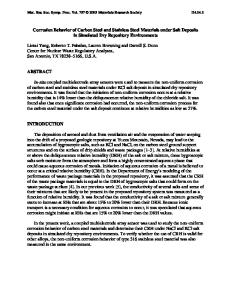Corrosion behavior of carbon steel rock bolt in simulated Yucca Mountain ground waters
- PDF / 717,787 Bytes
- 9 Pages / 612 x 792 pts (letter) Page_size
- 93 Downloads / 289 Views
INTRODUCTION
YUCCA Mountain (Nevada) is being characterized as the site for geological disposal of commercial spent nuclear fuel and other forms of high-level nuclear waste. Yucca Mountain is located about 160 km northwest of Las Vegas on land owned by the federal government.[1] The overall strategy in isolating high-level nuclear waste is to make use of the natural barriers present in the host geologic site along with the construction of a series of engineered barriers. The current waste package design consists of two concentric metal containers. The outer container is made of a Ni-22Cr-13Mo-3W Alloy 22 (N06022), which is among the most corrosion resistant of all engineering materials. The purpose of this outer container is to provide protection against corrosion. The inner container is thicker and made of nuclear grade type 316L stainless steel (S31603). The intended purpose of the inner barrier is to provide shield for radiation and mechanical integrity. The engineering barrier design also includes a detached drip shield that would be emplaced above the waste package to deflect any falling water or rocks from the walls of the emplacement onto the containers. The proposed material for the drip shield is Titanium Grade 7 or UNS R52400.[2] Carbon steel was an earlier candidate for the container material for the oxidizing and dry Yucca Mountain environment.[3] This is no longer the case; however, the character-
A. YILMAZ, Materials Scientist, and R.B. REBAK, Corrosion Scientist, are with the Lawrence Livermore National Laboratory, Livermore, CA 94550. Contact e-mail: [email protected] D. CHANDRA, Professor, is with the Metallurgical and Materials Science and Engineering Department, University of Nevada-Reno, Reno, NV 89557. This article is based on a presentation made in the symposium “Effect of Processing on Materials Properties for Nuclear Waste Disposition,” November 10–11, 2003, at the TMS Fall meeting in Chicago, Illinois, under the joint auspices of the TMS Corrosion and Environmental Effects and Nuclear Materials Committees. METALLURGICAL AND MATERIALS TRANSACTIONS A
ization of the corrosion behavior of carbon steels in Yucca Mountain type environments is important since other components in the drifts may still be constructed using carbon steels. These components included rock bolts, tunnel ribs, borehole liners or mesh, and inverts for the pedestals or pallets. Since 2004, austenitic stainless steel is being considered for the rock bolts and the mesh instead of carbon steel. Carbon steel and low alloy steels are still candidate materials for the containers in other countries.[3,4,5] For example, in Japan and Europe, carbon steel is considered a viable material for the waste containers since it is planned to emplace them deep below the water line where the environment is predicted to have a reducing redox potential.[4,5] The corrosion behavior of carbon steels in natural waters and in soil has been extensively studied.[6] For example, it is well known that the corrosion resistance of carbon steels in natural
Data Loading...











